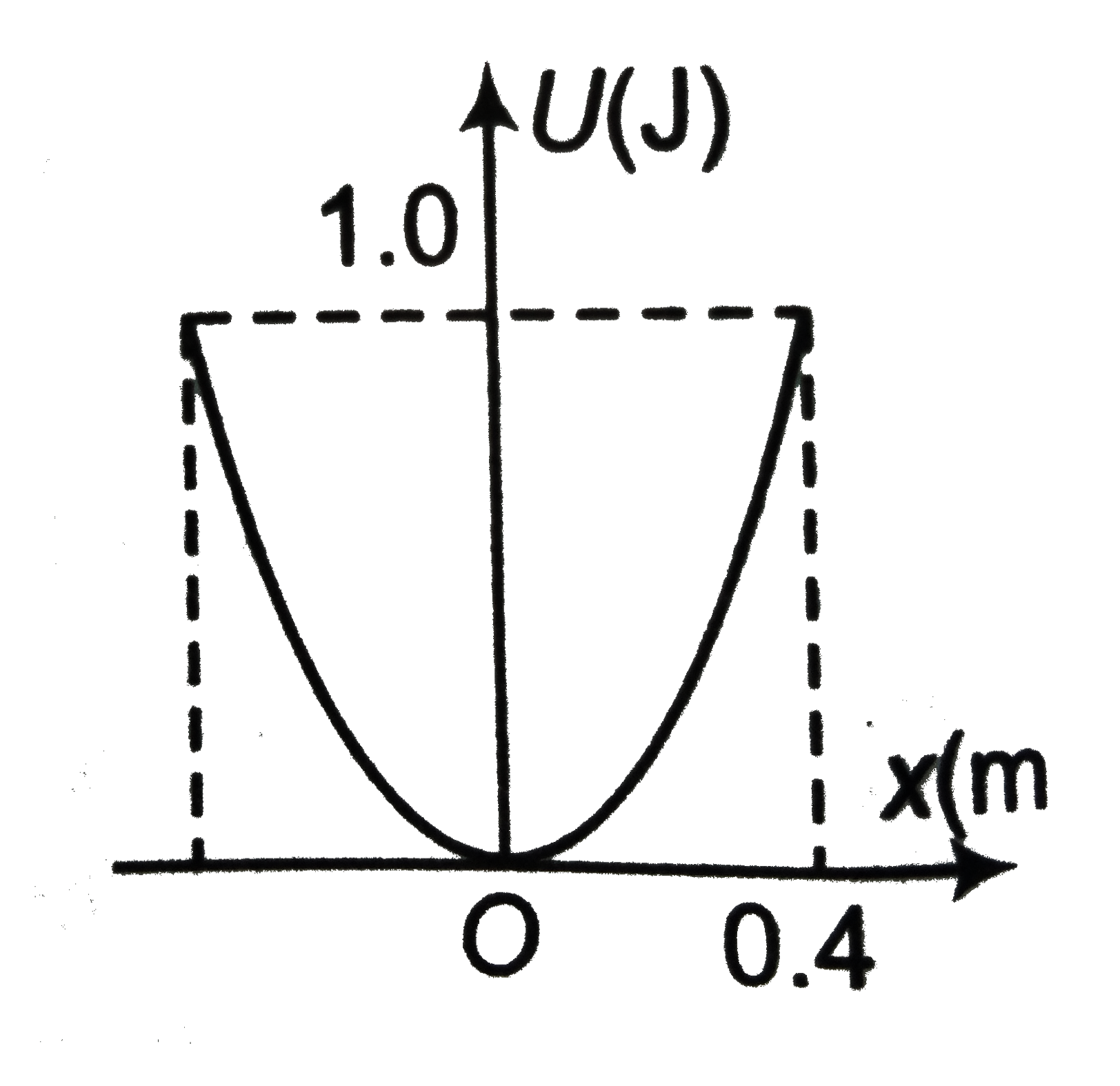The time period of a particle in simple harmonic motion is T. Assume potential energy at mean position to be zero. After a time of T6 it passes its mean position ,then at t=0 its,
velocity will be one half its maximum velocity
displacement will be one half of its amplitude
Acceleration will be nearly 86∘ of its maximum acceleration
kinetic energy = potential energy
The correct Answer is:A, C
To solve the problem, we need to analyze the motion of a particle in simple harmonic motion (SHM) given that the time period is T and the potential energy at the mean position is zero. We are given that the particle passes through its mean position after a time of T6.
1. Understanding SHM:
The displacement x of a particle in SHM can be represented as:
x(t)=Asin(ωt+ϕ)
where A is the amplitude, ω=2πT is the angular frequency, and ϕ is the phase constant.
2. Mean Position:
At the mean position, the displacement x is zero. We know that at t=T6, the particle passes through the mean position:
x(T6)=Asin(ωT6+ϕ)=0
This implies:
sin(2πT⋅T6+ϕ)=sin(π3+ϕ)=0
3. Finding Phase Constant:
The sine function is zero when its argument is nπ (where n is an integer). Therefore:
π3+ϕ=nπ
For the simplest case (taking n=0):
ϕ=−π3
4. Displacement Equation:
Substituting ϕ back into the displacement equation:
x(t)=Asin(ωt−π3)
5. Finding Displacement at t=0:
Now, we can find the displacement at t=0:
x(0)=Asin(−π3)=−A√32
This means the displacement at t=0 is approximately −0.866A.
6. Finding Velocity:
The velocity v(t) is given by the derivative of displacement:
v(t)=dxdt=Aωcos(ωt−π3)
At t=0:
v(0)=Aωcos(−π3)=Aω⋅12
The maximum velocity Vmax=Aω, thus:
v(0)=12Vmax
7. Finding Acceleration:
The acceleration a(t) is given by:
a(t)=dvdt=−Aω2sin(ωt−π3)
At t=0:
a(0)=−Aω2sin(−π3)=Aω2⋅√32
The maximum acceleration Amax=Aω2, thus:
a(0)=√32Amax≈0.866Amax
8. Potential and Kinetic Energy:
The potential energy U at x(0):
U=12kx2=12k(−A√32)2=38kA2
The kinetic energy K at t=0:
K=12mv2=12m(12Aω)2=18mA2ω2=18kA2
Conclusion:
- The displacement at t=0 is approximately −0.866A (not half of the amplitude).
- The velocity at t=0 is half of the maximum velocity.
- The acceleration at t=0 is approximately 0.866Amax.
- The potential and kinetic energies are not equal.
The displacement x of a particle in SHM can be represented as:
x(t)=Asin(ωt+ϕ)
where A is the amplitude, ω=2πT is the angular frequency, and ϕ is the phase constant.
At the mean position, the displacement x is zero. We know that at t=T6, the particle passes through the mean position:
x(T6)=Asin(ωT6+ϕ)=0
This implies:
sin(2πT⋅T6+ϕ)=sin(π3+ϕ)=0
The sine function is zero when its argument is nπ (where n is an integer). Therefore:
π3+ϕ=nπ
For the simplest case (taking n=0):
ϕ=−π3
Substituting ϕ back into the displacement equation:
x(t)=Asin(ωt−π3)
Now, we can find the displacement at t=0:
x(0)=Asin(−π3)=−A√32
This means the displacement at t=0 is approximately −0.866A.
The velocity v(t) is given by the derivative of displacement:
v(t)=dxdt=Aωcos(ωt−π3)
At t=0:
v(0)=Aωcos(−π3)=Aω⋅12
The maximum velocity Vmax=Aω, thus:
v(0)=12Vmax
The acceleration a(t) is given by:
a(t)=dvdt=−Aω2sin(ωt−π3)
At t=0:
a(0)=−Aω2sin(−π3)=Aω2⋅√32
The maximum acceleration Amax=Aω2, thus:
a(0)=√32Amax≈0.866Amax
The potential energy U at x(0):
U=12kx2=12k(−A√32)2=38kA2
The kinetic energy K at t=0:
K=12mv2=12m(12Aω)2=18mA2ω2=18kA2
- The displacement at t=0 is approximately −0.866A (not half of the amplitude).
- The velocity at t=0 is half of the maximum velocity.
- The acceleration at t=0 is approximately 0.866Amax.
- The potential and kinetic energies are not equal.
Topper's Solved these Questions
- SIMPLE HARMONIC MOTIONBOOK - DC PANDEY ENGLISHCHAPTER - SIMPLE HARMONIC MOTIONEXERCISE - Comprehension types
18 Videos
- SIMPLE HARMONIC MOTIONBOOK - DC PANDEY ENGLISHCHAPTER - SIMPLE HARMONIC MOTIONEXERCISE - Matrix matching type questions
13 Videos
- SIMPLE HARMONIC MOTIONBOOK - DC PANDEY ENGLISHCHAPTER - SIMPLE HARMONIC MOTIONEXERCISE - JEE Advanced
34 Videos
- SEMICONDUCTORS AND ELECTRONIC DEVICESBOOK - DC PANDEY ENGLISHCHAPTER - SEMICONDUCTORS AND ELECTRONIC DEVICESEXERCISE - More than One Option is Correct
3 Videos
- SOLVD PAPERS 2017 NEET, AIIMS & JIPMERBOOK - DC PANDEY ENGLISHCHAPTER - SOLVD PAPERS 2017 NEET, AIIMS & JIPMEREXERCISE - Solved paper 2018(JIPMER)
38 Videos
Similar Questions
The phase (at a time t) of a particle in simple harmonic motion tells
View SolutionThe time period of a particle executing SHM is T. After a time T/6 after it passes its mean position, then att=0 its :
View SolutionA particle of mass 2kg moves in simple harmonic motion and its potential energy U varies with position x as shown. The period of oscillation of the particle is

View SolutionA particle of mass 2kg moves in simple harmonic motion and its potential energy U varies with position x as shown. The period of oscillation of the particle is

View SolutionA particle executes a simple harmonic motion of time period T. Find the time taken by the particle to go directly from its mean position to half the amplitude.
View SolutionCan the potential energy in a Simple harmonic motion be negative ? will it be so if we choose zero potential energy at some point other than the mean position?
View SolutionA particle executes simple harmonic motion with an amplitude of 4cm At the mean position the velocity of the particle is 10cm/s. distance of the particle from the mean position when its speed 5 cm/s is
View SolutionPosition-time relationship of a particle executing simple harmonic motion is given by equation
x=2sin(50πt+2π3) where x is in meters and time t is in seconds.
What is the position of particle at t=0 ?
View SolutionPosition-time relationship of a particle executing simple harmonic motion is given by equation
x=2sin(50πt+2π3) where x is in meters and time t is in seconds.
What is the position of particle at t=0.5s ?
View SolutionThe simple harmonic motion of a particle is given by x = a sin 2πt . Then, the location of the particle from its mean position at a time 1/8th of second is
View Solution